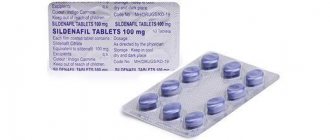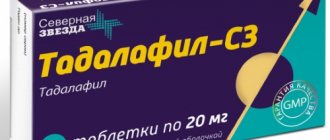Effex Sildenafil, 100 mg, film-coated tablets, 15 pcs.
To diagnose erectile dysfunction, determine its possible causes and select adequate treatment, it is necessary to obtain a complete medical history and conduct a thorough physical examination. Erectile dysfunction treatments should be used with caution in patients with anatomical deformation of the penis (angulation, cavernous fibrosis, Peyronie's disease), or in patients with risk factors for priapism (sickle cell anemia, multiple myeloma, leukemia, thrombocythemia) (see section C caution").
During post-marketing studies, cases of prolonged erection and priapism have been reported. If an erection persists for more than 4 hours, you should immediately seek medical help. If treatment for priapism is not carried out immediately, it can lead to damage to the tissue of the penis and irreversible loss of potency.
Medicines intended to treat erectile dysfunction should not be prescribed to men for whom sexual activity is undesirable.
Sexual activity poses a certain risk in the presence of heart disease, so before starting any therapy for erectile dysfunction, the doctor should refer the patient for an examination of the condition of the cardiovascular system. Sexual activity is undesirable in patients with heart failure, unstable angina, stroke or myocardial infarction in the last 6 months, life-threatening arrhythmias, arterial hypertension (BP > 170/100 mm Hg) or hypotension (BP < 90/50 mm Hg. Art.) (see section Contraindications"). Clinical studies have shown no difference in the incidence of myocardial infarction (1.1 per 100 people per year) or the incidence of cardiovascular mortality (0.3 per 100 people per year) in patients treated with sildenafil compared with patients treated with sildenafil. those receiving placebo.
Cardiovascular complications
During post-marketing use of sildenafil for the treatment of erectile dysfunction, adverse events such as serious cardiovascular events (including myocardial infarction, unstable angina, sudden cardiac death, ventricular arrhythmia, hemorrhagic stroke, transient ischemic attack, hypertension and hypotension) have been reported. ), which had a temporary association with the use of sildenafil. Most of these patients, but not all of them, had risk factors for cardiovascular complications. Many of these adverse events occurred shortly after sexual activity, and some of them occurred after taking sildenafil without subsequent sexual activity. It is not possible to establish a direct connection between the observed adverse events and these or other factors.
Hypotension
Sildenafil has a systemic vasodilating effect, leading to a transient decrease in blood pressure, which is not a clinically significant phenomenon and does not lead to any consequences in most patients. However, before prescribing sildenafil, the physician should carefully assess the risk of possible undesirable manifestations of the vasodilating effect in patients with relevant diseases, especially against the background of sexual activity. Increased susceptibility to vasodilators is observed in patients with obstruction of the left ventricular outflow tract (aortic stenosis, hypertrophic obstructive cardiomyopathy), as well as with the rare syndrome of multiple system atrophy, manifested by severe dysregulation of blood pressure from the autonomic nervous system.
Since the combined use of sildenafil and α-blockers can lead to symptomatic hypotension in some sensitive patients, sildenafil should be administered with caution to patients taking α-blockers (see section "Interaction with other drugs"). To minimize the risk of postural hypotension in patients taking α-blockers, sildenafil should be started only after hemodynamic stability has been achieved in these patients. You should also consider the advisability of reducing the initial dose of sildenafil (see section "Dosage and Administration"). The physician should inform patients about what actions to take if symptoms of postural hypotension occur.
Visual impairment
In rare cases, non-arteritic anterior ischemic optic neuropathy (NAION), a rare condition and cause of vision loss or reduction, has been reported during post-marketing use of all PDE5 inhibitors, including sildenafil. Most of these patients had risk factors, including decreased papilledema/disc ratio (“congestive disc”), age over 50 years, diabetes mellitus, hypertension, coronary artery disease, hyperlipidemia, and smoking. An observational study assessed whether recent use of the PDE5 inhibitor class of drugs was associated with acute onset of NPINSID. Results indicate an approximately 2-fold increase in the risk of NPINSID within 5 half-lives of PDE5 inhibitor use. According to the published literature, the annual incidence of NPINSID is 2.5 – 11.8 cases per 100,000 men aged ≥ 50 years in the general population. In case of sudden loss of vision, patients should be advised to stop sildenafil therapy and consult a doctor immediately. Individuals who have already had a case of NPIND have an increased risk of recurrent NPIND. Therefore, the physician should discuss this risk with such patients, as well as discuss with them the potential for adverse effects from PDE5 inhibitors. PDE5 inhibitors, including sildenafil, should be used with caution in such patients and only in situations where the expected benefit outweighs the risk.
A small number of patients with hereditary retinitis pigmentosa have genetically determined dysfunction of retinal phosphodiesterases. There is no information on the safety of sildenafil in patients with retinitis pigmentosa, so the drug should be used with caution (see section "With caution").
Hearing impairment
Some post-marketing and clinical studies have reported cases of sudden deterioration or loss of hearing associated with the use of all PDE5 inhibitors, including sildenafil. Most of these patients had risk factors for sudden deterioration or loss of hearing. A cause-and-effect relationship between the use of PDE5 inhibitors and sudden hearing loss or deterioration has not been established. If there is a sudden deterioration in hearing or hearing loss while taking sildenafil, you should consult your doctor immediately.
Bleeding
Sildenafil enhances the antiplatelet effect of sodium nitroprusside, a nitric oxide donor, on human platelets in vitro. There are no data on the safety of sildenafil in patients with a tendency to bleeding or exacerbation of gastric and duodenal ulcers, so sildenafil should be used with caution in these patients (see section "With caution"). The incidence of epistaxis in patients with pulmonary hypertension associated with diffuse connective tissue diseases was higher (sildenafil 12.9%, placebo 0%) than in patients with primary pulmonary hypertension (sildenafil 3.0%, placebo 2.4%) . Patients receiving sildenafil in combination with a vitamin K antagonist had a higher incidence of epistaxis (8.8%) than patients not receiving a vitamin K antagonist (1.7%).
Use in conjunction with other means of treating erectile dysfunction
The safety and effectiveness of sildenafil in combination with other PDE5 inhibitors or other drugs for the treatment of pulmonary hypertension containing sildenafil (for example, Revazio®) or other drugs for the treatment of erectile dysfunction have not been studied, therefore the use of such combinations is not recommended (see section "Contraindications").
Impact on the ability to drive vehicles and machinery
Since when taking sildenafil, it is possible to develop dizziness, decrease in blood pressure, develop chromatopsia, blurred vision, etc. side effects, caution should be exercised when driving vehicles and engaging in other potentially hazardous activities that require increased concentration and speed of psychomotor reactions. You should also be careful about the individual effect of the drug in these situations, especially at the beginning of treatment and when changing the dosage regimen.
EFFEX® Sildenafil (EFFAX® Sildenafil)
To diagnose erectile dysfunction, determine its possible causes and select adequate treatment, it is necessary to obtain a complete medical history and conduct a thorough physical examination.
Erectile dysfunction treatments should be used with caution in patients with anatomical deformation of the penis (angulation, cavernous fibrosis, Peyronie's disease), or in patients with risk factors for priapism (sickle cell anemia, multiple myeloma, leukemia, thrombocythemia) (see section C caution").
During post-marketing studies, cases of prolonged erection and priapism have been reported. If an erection persists for more than 4 hours, you should immediately seek medical help. If treatment for priapism is not carried out immediately, it can lead to damage to the tissue of the penis and irreversible loss of potency.
Medicines intended to treat erectile dysfunction should not be prescribed to men for whom sexual activity is undesirable.
Sexual activity poses a certain risk in the presence of heart disease, so before starting any therapy for erectile dysfunction, the doctor should refer the patient for an examination of the condition of the cardiovascular system. Sexual activity is undesirable in patients with heart failure, unstable angina, stroke or myocardial infarction in the last 6 months, life-threatening arrhythmias, arterial hypertension (BP > 170/100 mm Hg) or hypotension (BP < 90/50 mm Hg. Art.) (see section Contraindications").
Clinical studies have shown no difference in the incidence of myocardial infarction (1.1 per 100 people per year) or the incidence of cardiovascular mortality (0.3 per 100 people per year) in patients treated with sildenafil compared with patients treated with sildenafil. those receiving placebo.
Cardiovascular complications
During post-marketing use of sildenafil for the treatment of erectile dysfunction, adverse events such as serious cardiovascular events (including myocardial infarction, unstable angina, sudden cardiac death, ventricular arrhythmia, hemorrhagic stroke, transient ischemic attack, hypertension and hypotension) have been reported. ), which had a temporary association with the use of sildenafil. Most of these patients, but not all of them, had risk factors for cardiovascular complications. Many of these adverse events occurred shortly after sexual activity, and some of them occurred after taking sildenafil without subsequent sexual activity. It is not possible to establish a direct connection between the observed adverse events and these or other factors.
Hypotension
Sildenafil has a systemic vasodilating effect, leading to a transient decrease in blood pressure, which is not a clinically significant phenomenon and does not lead to any consequences in most patients. However, before prescribing sildenafil, the physician should carefully assess the risk of possible unwanted manifestations of the vasodilating effect in patients with relevant diseases, especially against the background of sexual activity.
Increased susceptibility to vasodilators is observed in patients with obstruction of the left ventricular outflow tract (aortic stenosis, hypertrophic obstructive cardiomyopathy), as well as with the rare syndrome of multiple system atrophy, manifested by severe dysregulation of blood pressure from the autonomic nervous system.
Since the combined use of sildenafil and α-blockers can lead to symptomatic hypotension in some sensitive patients, sildenafil should be administered with caution to patients taking α-blockers (see section "Interaction with other drugs"). To minimize the risk of postural hypotension in patients taking α-blockers, sildenafil should be started only after hemodynamic stability has been achieved in these patients. You should also consider the advisability of reducing the initial dose of sildenafil (see section "Dosage and Administration"). The physician should inform patients about what actions to take if symptoms of postural hypotension occur.
Visual impairment
In rare cases, non-arteritic anterior ischemic optic neuropathy (NAION), a rare condition and cause of vision loss or reduction, has been reported during post-marketing use of all PDE5 inhibitors, including sildenafil. Most of these patients had risk factors, including decreased papilledema/disc ratio (“congestive disc”), age over 50 years, diabetes mellitus, hypertension, coronary artery disease, hyperlipidemia, and smoking. An observational study assessed whether recent use of the PDE5 inhibitor class of drugs was associated with acute onset of NPINSID. Results indicate an approximately 2-fold increase in the risk of NPINSID within 5 half-lives of PDE5 inhibitor use. According to the published literature, the annual incidence of NPINSID is 2.5-11.8 cases per 100,000 men aged ≥ 50 years in the general population.
In case of sudden loss of vision, patients should be advised to stop sildenafil therapy and consult a doctor immediately. Individuals who have already had a case of NPIND have an increased risk of recurrent NPIND. Therefore, the physician should discuss this risk with such patients, as well as discuss with them the potential for adverse effects from PDE5 inhibitors. PDE5 inhibitors, including sildenafil, should be used with caution in such patients and only in situations where the expected benefit outweighs the risk.
A small number of patients with hereditary retinitis pigmentosa have genetically determined dysfunction of retinal phosphodyseterases. There is no information on the safety of sildenafil in patients with retinitis pigmentosa, so the drug should be used with caution (see section "With caution").
Hearing impairment
Some post-marketing and clinical studies have reported cases of sudden deterioration or loss of hearing associated with the use of all PDE5 inhibitors, including sildenafil, the majority of these patients had risk factors for sudden deterioration or loss of hearing. A cause-and-effect relationship between the use of PDE5 inhibitors and sudden hearing loss or deterioration has not been established. If there is a sudden deterioration in hearing or hearing loss while taking sildenafil, you should consult your doctor immediately.
Bleeding
Sildenafil enhances the antiplatelet effect of sodium nitroprusside, a nitric oxide donor, on human platelets in vitro. There are no data on the safety of sildenafil in patients with a tendency to bleeding or exacerbation of gastric and duodenal ulcers, so sildenafil should be used with caution in these patients (see section "With caution").
The incidence of epistaxis in patients with pulmonary hypertension associated with diffuse connective tissue diseases was higher (sildenafil 12.9%, placebo 0%) than in patients with primary pulmonary hypertension (sildenafil 3.0%, placebo 2.4%) . Patients receiving sildenafil in combination with a vitamin K antagonist had a higher incidence of epistaxis (8.8%) than patients not receiving a vitamin K antagonist (1.7%).
Use in conjunction with other treatments for erectile dysfunction
The safety and effectiveness of sildenafil in combination with other PDE5 inhibitors or other drugs for the treatment of pulmonary hypertension containing sildenafil (for example, Revatio®) or other drugs for the treatment of erectile dysfunction have not been studied, therefore the use of such combinations is not recommended (see section "Contraindications").



